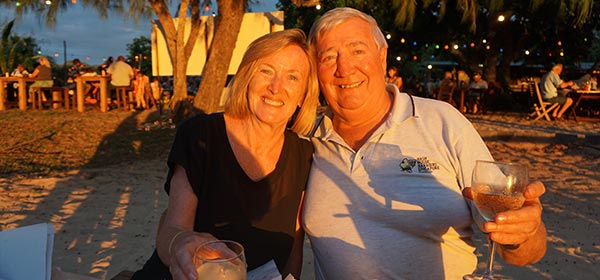Cape York, ‘The Tip’, far Far North Queensland: a place most Australians will never get to and perhaps don’t even think about visiting. Reaching that northern most point is an adventure. Now I can say we have been there and pulled our Kimberley T3 caravan all the way. And, there is red dust everywhere to prove it.

The trip began on a cold, wet Melbourne morning as we travelled into Central Queensland and up to hot and dry Karumba on the Gulf of Carpentaria. The journey touched outback towns such as Lightning Ridge (no luck fossicking), Bourke (as in ‘the back of’), Winton (with the Tattersalls Hotel – no Lotto win but excellent meals and music), and then to Longreach (the birth of Qantas and the Stockman Hall of Fame ). We saw many towns struggling to survive the harsh Australian conditions and, of course, many bush camps with comforting campfires. Three weeks – and many adventures – later we reached Cooktown. Here we were welcomed at the Saturday market by an Australian Army band playing music by Jimmy Barnes … Apparently they also do marches!

A highlight tucked away in Cooktown’s Botanic Gardens was Nature’s Powerhouse, a gallery of botanical illustrations by Vera Scarth-Johnson presented alongside those by Joseph Banks, which he produced while waiting for the Endeavour to be repaired.
The James Cook Museum provided tourist information for the 789km journey to Punsand Bay at The Tip.
Dry weather was the general forecast for the trip, which comprised a mix of black top and corrugated roads, and a horrible stretch of corrugations near the Jardine River ferry (‘near’ in local terms is about 40km!). The best advice came from a fellow traveller: “Drive in the gutters.”

We had already planned to bypass the Old Telegraph Track, accurately described as a 4WD ‘adventure’, but for many this was the dream.
As it turned out, the dirt roads in some parts had been recently graded, which lulled you into a sense of relief, but other parts were truly ugly. Wide deep corrugations – too wide for just riding the black tops at speed – and at times, 20km per hour was both too fast and too slow. So, into those gutters we went – they were just wide enough for the car and the T3, with a sandy base, which helped us to bypass some of the worst of it. Steadily the distance dissolved and we emerged intact. They say in a few years it will be all black top to The Tip, but I’m not sure the small towns and roadhouses could handle the traffic, and the adventure and challenge would be diminished.
Pit stops were planned around the roadhouses. They provide fuel, food (if needed), and a few camps had entertainment by bush poets. In these campgrounds, there is always advice and tales from southbound travellers being passed to the newbies heading north. Most sites have cabins for road-trippers who don’t want to camp.

Our next stops included Coen, Hann River, Archer River, Musgrave, Bramwell Station, and finally Bamaga, the main township of the Torres Strait Island region. Each had its own character, and often friendly service from backpackers working in these remote areas. Apart from these main stops, there are about 18 side trips through National Parks and settlements. Plenty to explore for next time.
At Bamaga, we stayed at Loyalty Beach, a rustic and laid-back environment with stunning sea views and a picturesque beach bar serving three meals a day.
To reach The Tip, it was just a short 32km drive and a walk over the headland. Stop at the Croc Tent to collect a local map and maybe a souvenir. It is possible to stay at a lovely campsite, Punsand Bay, but that was a road too far for our van.

We parked among the many other four-wheel drives at Pajinka (The Tip) and were reminded you that you can’t get away from civilisation. The walk over the headland provided views of the Torres Strait Islands – Thursday is the most well known, along with Horn Island, which played a significant role in the Second World War. Finally, we descended to sea level and stood beside a very modest sign proclaiming the northern-most point of the continent. After photos, we reluctantly returned to the car – via a pristine beach – and started planning side trips for our journey south.
Related articles:
Road tripping – what a way to see Australia
Seven best apps for road trippers
10 tips for happy road trips

